Stay Updated with Everything about MDS
Thank you! Your submission has been received!
Oops! Something went wrong while submitting the form.
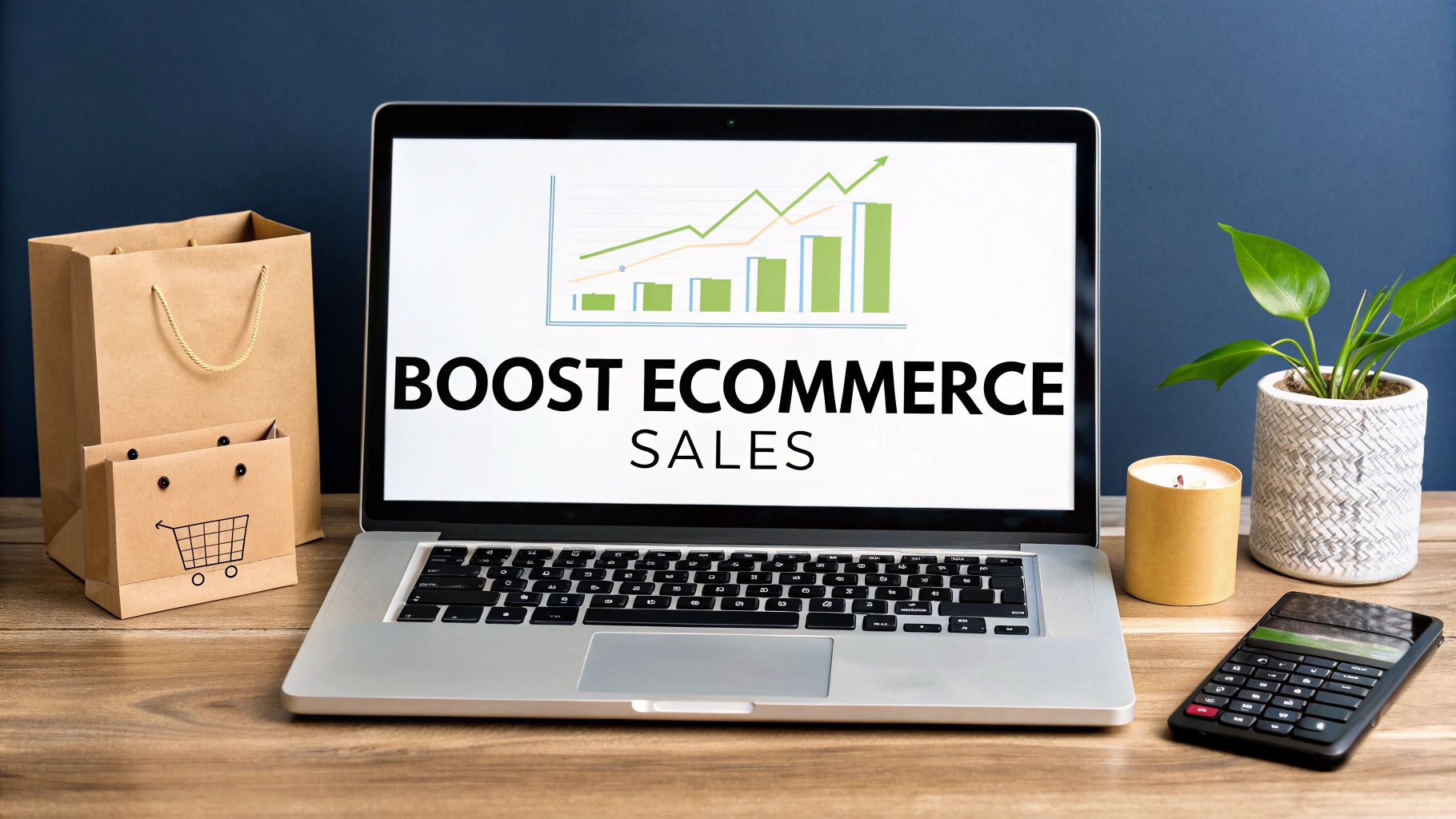
Chilat Doina
August 3, 2025
If you're looking to boost your ecommerce sales, it's easy to get lost in the weeds. The truth is, it all comes down to nailing four core areas: refining your website, mastering your marketing, keeping customers happy, and actually using your data.
When these four pieces work together, they create a powerful engine that doesn't just attract visitors—it turns them into loyal, repeat customers.
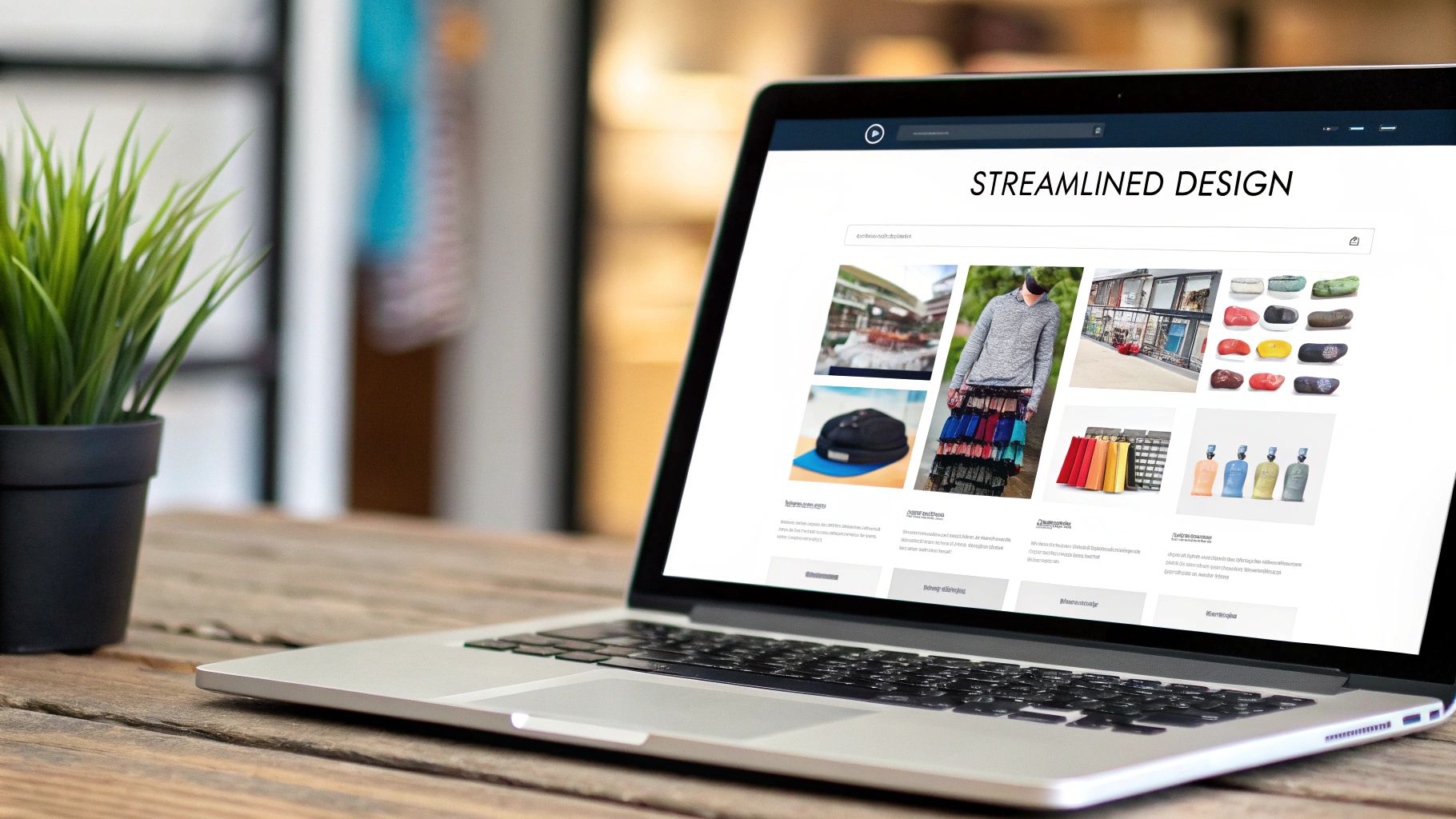
Before we jump into specific tactics, let's look at the big picture. Think of this as your roadmap for sustainable growth, helping you focus your time and money where it will have the biggest impact. It’s the executive summary of where sales are won and lost online.
A great starting point for any brand is to build an effective ecommerce SEO strategy that lines up perfectly with your overall business goals.
Your entire journey to more sales is built on these four fundamental pillars. Each one supports the others, creating a powerful cycle of attracting, converting, and keeping customers for the long haul.
Optimizing Your Store: This is all about the user experience. We're talking lightning-fast page loads and a mobile checkout process so smooth that customers don't even think about it. Even tiny points of friction can add up to huge losses in revenue.
Choosing the Right Channels: Don't just throw your marketing budget at every channel hoping something sticks. You need to identify and dominate the platforms—whether that’s paid search, social media, or email—that bring you the highest return for your specific brand.
Building Customer Loyalty: Getting a new customer is expensive; keeping one is where the real profit is. This pillar is about smart strategies like loyalty programs and personalized communication that dramatically increase what each customer is worth to you over their lifetime.
Using Data for Decisions: Stop guessing and start knowing. Your analytics are a goldmine for understanding what your customers actually do, tracking your most important metrics, and running tests that directly improve your bottom line.
The digital marketplace is absolutely booming. Global ecommerce sales are on track to skyrocket from $4.2 trillion in 2020 to a massive $8.3 trillion by 2025.
That’s a staggering 97.6% jump. This isn't just a trend; it's a fundamental consumer shift online, fueled by everyone shopping on their phones and the rise of new digital payment options.
To give you a quick overview, here’s a breakdown of the core pillars and how they contribute to your bottom line.
Focusing on these interconnected areas provides a clear and proven path to sustainable ecommerce growth.
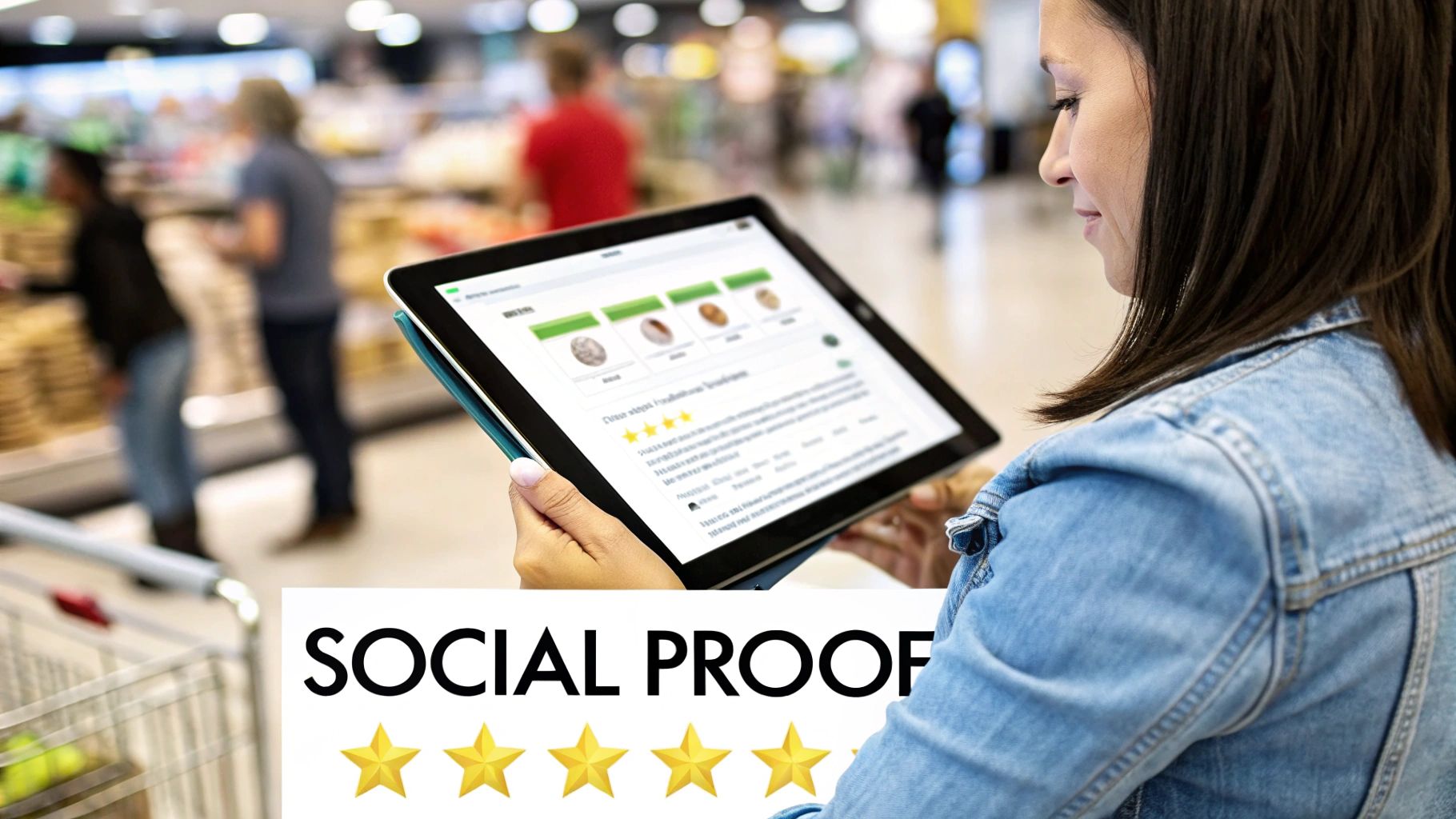
Your website is your digital storefront, but there's a key difference: a customer can walk out with a single, frustrated click. We've seen it happen time and time again. Seemingly small points of friction—a page that takes an extra second to load, a confusing menu—quietly bleed your sales dry.
The goal isn't just about pouring more money into ads to get more traffic. It’s about converting the visitors you already have. That means digging into the nuts and bolts of the shopping experience itself. From the moment they land on your site to the final thank you page, every single element should be engineered to make buying from you feel simple, obvious, and secure.
In ecommerce, speed isn't a "nice-to-have." It's a core feature. A sluggish site is a leaky bucket. Just a one-second delay in page load can slash your conversions by up to 7%. For a store pulling in $100,000 a day, that's a staggering $2.5 million loss over a year.
The first step is a no-nonsense site speed audit. Use a tool like Google PageSpeed Insights to get a clear picture of what’s holding you back.
From my experience, it usually boils down to a few usual suspects:
And here’s the reality check: over 70% of ecommerce sales now happen on a phone. "Mobile-first" isn't just a buzzword; it's a mandate. This means you design for the small screen first, not as an afterthought. Relentlessly test your mobile checkout. Is it a pain to type in credit card numbers? Can customers fly through with Apple Pay or Google Pay? Every tap counts.
People are smart, and they’re rightfully cautious about where they spend their money online. You have to earn their trust before they’ll even think about pulling out their wallet. This isn't about grand gestures; it's about a hundred small, consistent signals that tell them you're legit.
Key Takeaway: Trust is the real currency of ecommerce. It's built with transparency, undeniable social proof, and clear signs of security. Without it, the best product in the world won't sell.
Plaster those security badges from names like Norton or McAfee on your cart and checkout pages. Make your return policy and shipping info dead simple to find and even simpler to understand. Ambiguity creates doubt, and doubt absolutely kills conversions.
Nothing builds trust like social proof. Reviews and photos from actual customers are your secret weapon. Don't just show a 4.5-star rating; feature detailed reviews that address common concerns. Better yet, add a Q&A section where past buyers can answer questions from shoppers on the fence. It's an incredibly powerful way to build community and erase any last-minute hesitation.
Your product page has one job: convince a visitor that your product is the answer they've been looking for. Stop listing features and start selling outcomes. Instead of saying your backpack has "water-resistant nylon," tell them it "keeps your laptop bone-dry in a surprise downpour." Show, don't just tell, with high-quality images and video of the product in action.
The final boss battle is the checkout. This is where a shocking number of sales go to die. The average cart abandonment rate hovers around 70%, usually because of a surprise shipping cost or a clunky, demanding process. To master this, there are many proven strategies to reduce shopping cart abandonment that offer practical solutions.
Here’s a quick checklist to smooth out your checkout flow:
Every single conversion you claw back by fixing these on-site issues flows directly to your profit margin. It's one of the most effective ways to learn how to increase profitability without just throwing more money at ads.
Throwing your marketing budget around without a clear strategy is a lot like trying to find your way through a new city without a map. Sure, you'll end up somewhere, but it's probably not where you wanted to go. The real secret to boosting your ecommerce sales isn't just spending more—it's about getting smarter and investing in the channels that actually deliver for your specific brand.
Let's be honest, not every channel is a home run for every store. A high-end skincare brand might absolutely kill it on Instagram and with beauty influencers. On the other hand, a shop selling specialized industrial parts will likely find its best customers through laser-focused Google Ads.
The game is about pinpointing where your audience hangs out online and showing up with a message that resonates.
When someone types "men's waterproof leather boots size 11" into Google, they aren't just window shopping. They've got their wallet out. This is the raw power of paid search; it lets you jump in front of customers at that critical moment of high purchase intent.
But success here isn't just about outbidding everyone on keywords. It's about precision.
Nail these details, and you'll transform paid search from a budget black hole into a predictable engine for driving sales.
Social media isn't just a digital billboard for your products. It's a place to build a tribe. People are far more likely to buy from brands they feel a real connection to, and these platforms are the perfect spot to start that conversation. Think less about the hard sell and more about genuine engagement.
For instance, a fitness apparel brand could start a private Facebook group for customers to share workout tips and progress pics. A coffee subscription company might run a weekly Instagram Live session where they brew and discuss a new blend. It creates a sense of belonging that turns one-time buyers into brand evangelists. It definitely takes more effort than just running an ad, but the loyalty it creates is priceless.
The infographic below highlights some typical engagement benchmarks for another crucial channel we're about to dive into: email marketing.
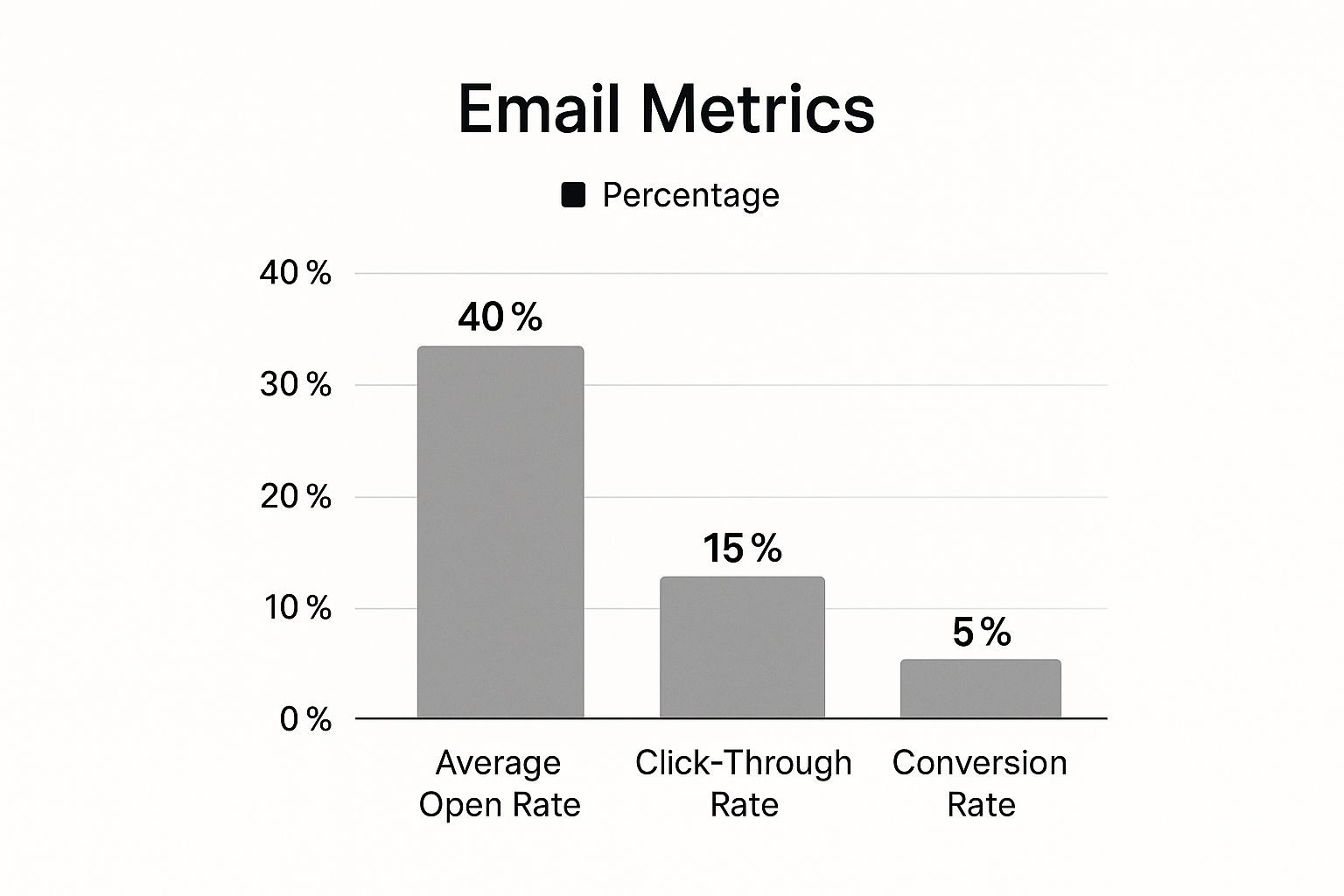
As you can see, plenty of people might open an email, but only a fraction click through, and even fewer actually buy. This really drives home the need for powerful, targeted email strategies that go beyond the basics.
Year after year, email marketing delivers one of the highest returns on investment of any channel out there. Why? Because you're talking directly to an audience that has already raised their hand and said, "Yes, I want to hear from you."
A well-crafted email campaign is a direct conversation with your customer. From a warm welcome to a gentle reminder about an abandoned cart, it’s your chance to guide them personally through the buying journey.
Your email strategy shouldn't be about random promotional blasts. It should be a series of automated conversations designed to help your customers.
As these channels become more competitive, the good news is that the market itself is growing. Let’s look at the projected growth in global ecommerce sales.
This steady expansion just underscores why mastering your marketing channels is so critical for capturing your piece of the pie. For an even deeper look at channel-specific tactics, our complete guide to ecommerce marketing strategies is a great next step.
Look, driving traffic and getting that first sale feels like a huge win. And it is. But the real secret to building a lasting ecommerce brand? It's not about that first purchase. It's about getting the second, third, and tenth.
It’s an old saying in this business, but it’s true: acquiring a new customer costs five times more than keeping one you already have. The smartest brands I know are obsessed with retention. They understand that a loyal customer base isn't just nice to have—it's predictable, recurring revenue that you can build a stable business on.
This isn't about running a flash sale here and there. It's about building a real system that turns one-time buyers into genuine fans of your brand. That's how you seriously boost your customer lifetime value (CLV).
Let's be honest, the old "earn one point for every dollar" trick is played out. Customers see right through it. To get people genuinely excited, your loyalty program needs to feel less like a marketing ploy and more like an exclusive club with real, tangible perks.
Think beyond basic points. What if you created tiered rewards? I’ve seen outdoor gear brands crush it with this. They’ll set up a VIP tier for their top customers offering early access to new product drops, a private customer service line, or even invites to brand-sponsored meetups. That creates a sense of status that a simple 10% discount could never replicate.
A few ideas to get you started:
The conversation shouldn't stop the moment a customer’s order ships. That post-purchase window is a golden opportunity to build on the initial excitement and lay the groundwork for their next purchase. This is where you need to get smart with your email follow-ups.
Stop sending generic "thanks for your order" blasts. Tailor your communication based on what they actually bought.
Let's say someone just bought a high-end espresso machine from you. Your follow-up sequence could look like this:
Key Insight: The goal here is to help, not just sell. When you provide genuine value and show you understand their journey, you shift from a simple transaction to a trusted relationship. That's the heart of real loyalty.
This targeted approach proves you're paying attention and makes your marketing feel genuinely helpful. It’s a core piece of any strategy for ecommerce customer retention that actually moves the needle.
Your happiest customers can be your best marketers, and your unhappy ones? They're your most honest (and free) consultants. If you want to grow long-term, you have to make it incredibly easy for customers to give you feedback.
Don't just sit back and wait for reviews. Proactively ask for them.
Use your post-purchase emails to ask about their entire experience—from how easy the checkout was to what they thought of the packaging. And when you get negative feedback, don't just process a refund and move on. Reach out personally. Understand what went wrong and do whatever it takes to make it right. I’ve seen a single, amazing recovery experience create more loyalty than a dozen perfect orders.
When you actively listen and act on what your customers are telling you, you create a powerful feedback loop. You're not just improving your products; you're showing your customers they have a voice and are a valued part of your brand's story.
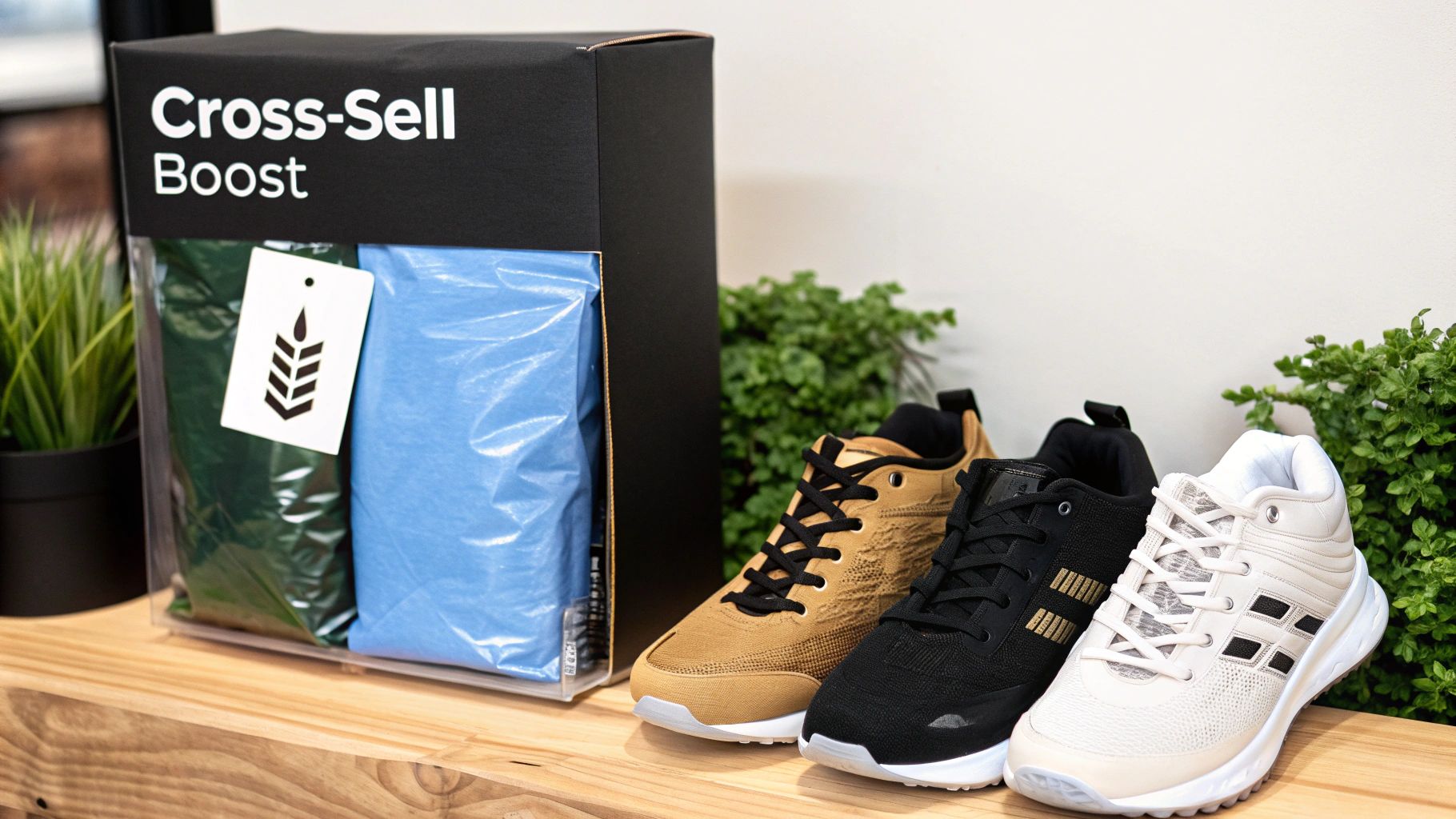
Data without purpose is just noise. In the world of ecommerce, that purpose is crystal clear: find out what's working, figure out what isn't, and make smarter choices that actually increase your ecommerce sales. Guesswork is an expensive habit. Insight is what pays the bills.
It all starts with getting out of the data swamp. Stop drowning in a sea of meaningless numbers and focus on the key performance indicators (KPIs) that truly move the needle. A clean, effective analytics dashboard doesn't track everything—it tracks the right things. This is how you turn raw data into a real strategic advantage.
I see so many store owners get hung up on vanity metrics. Things like total site traffic or social media likes feel good, but they don't directly translate to revenue. The real story of your business's health is told through a handful of core ecommerce metrics.
Here are the essentials you should be watching like a hawk:
Average Order Value (AOV): This is the average amount a customer drops in a single transaction. If your AOV is climbing, it's a great sign that your upselling, cross-selling, and product bundling strategies are hitting the mark. It's one of the quickest ways to boost revenue without spending a dime more on ads.
Customer Lifetime Value (CLV): This number tells you the total revenue you can realistically expect from a single customer over their entire relationship with your brand. A high CLV is the ultimate sign of a healthy, sustainable business built on a foundation of loyalty.
Conversion Rate: The percentage of visitors who take the action you want them to—usually, making a purchase. It's the most direct measure of how well your website, product pages, and checkout process are actually working together.
Cart Abandonment Rate: This shows you how many shoppers add items to their cart but bail before completing the purchase. A high rate is a huge red flag, often pointing to friction like unexpected shipping costs or a checkout process that's just too complicated.
My Personal Tip: Never look at these numbers in a vacuum. They tell a story together. For example, if a marketing campaign sends a flood of traffic your way (great!) but your AOV and conversion rate both tank (not so great!), that campaign might be a dud. Context is everything.
Once you're tracking the right metrics, you can start making them better. Your best friend here is A/B testing, also known as split testing. The concept is simple: you create two versions of a webpage (an 'A' and a 'B'), show each version to a different slice of your audience, and see which one performs better on your target KPI.
Forget about testing random button colors. You'll get real answers by focusing on high-impact experiments.
High-Impact A/B Testing Ideas:
The golden rule of A/B testing is to change only one significant element at a time. If you change the headline, the main image, and the call-to-action button all at once, you'll have no idea which change actually drove the results.
While A/B tests help you optimize your pages, cohort analysis helps you understand your people. A cohort is simply a group of users who share a common trait. Most often, it's the date they made their first purchase (for instance, all customers who first bought from you in January).
Tracking these cohorts over time unlocks a goldmine of insights and helps you answer critical business questions:
This kind of analysis shows you who your most valuable customers are and what makes them tick. It allows you to move beyond broad, generic strategies and start creating personalized marketing and retention efforts that truly fuel sustainable growth.
Theory is one thing, but seeing how these strategies play out in the real world? That’s where the magic really happens. Let's dig into a few stories of real ecommerce brands who put these ideas to work and saw some incredible results. Think of these less as stories and more as blueprints you can borrow from.
Picture a direct-to-consumer fashion brand that was bleeding money from abandoned carts. They were getting tons of eyeballs on their product pages, but shoppers were bailing right at the finish line. A quick look at their analytics showed the problem wasn't the products—it was their clunky, multi-page checkout process.
Their fix was simple but incredibly effective. They switched to a single-page checkout, threw in express payment options like Apple Pay, and put shipping costs right up front—no surprises. The payoff? A massive 35% jump in conversions in just one quarter. It’s a perfect example of how smoothing out the final step is one of the quickest wins for boosting sales.
Now, let's talk about a DTC brand selling organic snacks. They were decent at getting first-time buyers but were really struggling to get anyone to come back for a second purchase. So, they flipped their focus from constantly chasing new customers to building a real community around the ones they already had.
They rolled out a tiered loyalty program that was about more than just points.
This approach turned shopping into a bit of a game and made customers feel like they were part of an exclusive club. By rewarding their top customers with status and unique perks, they doubled their repeat purchase rate in only six months. That created a much healthier, more predictable stream of revenue.
This shift really drives home a core truth in ecommerce: your most profitable customer is almost always the one you've already won over. A loyalty system isn't just another expense; it's a powerful engine for growth.
Finally, consider a tech gadget store that was dumping most of its marketing budget into the usual suspects—Google and Facebook ads. But their returns were getting worse and worse, with customer acquisition costs soaring and growth hitting a wall. They decided it was time for an audit and took a chance on a channel they'd completely ignored: affiliate marketing with niche tech bloggers and YouTubers.
Instead of paying for clicks, they paid a commission on actual sales. This move was a game-changer for their ad spend efficiency. The authentic, detailed reviews from creators they partnered with built a kind of trust their own ads could never achieve. This pivot didn't just bring in high-quality traffic; it tapped into a whole new audience and sent their sales through the roof.
These examples show just how much the ecommerce game has changed, especially after the pandemic fast-tracked everyone's online shopping habits. The global market exploded, jumping by a staggering $897 billion in 2020 alone as people shifted their buying online. While things have settled down a bit since then, that surge set a new standard. The market is now projected to hit an eye-watering $8.03 trillion by 2027. If you want to dive deeper into how these trends are shaping the future, you can read some detailed ecommerce growth research on soax.com.
Of all the challenges store owners face, a few core questions always seem to bubble up to the surface when it comes to growth. Getting past a revenue plateau means finding clear, straight-to-the-point answers to these tough questions.
Let's dive into some of the most common ones I hear and break down what actually moves the needle.
When you need to see a sales bump now, you have to focus on high-impact tactics that don’t require a six-month strategy overhaul.
A classic for a reason is the flash sale, but with a twist—make sure you have a very visible countdown timer. That urgency is a powerful psychological trigger that gets shoppers to stop browsing and start buying.
Another quick win is sitting right inside your ad account. Go look at your top-performing ad campaigns, the ones already delivering a solid return. Don't overthink it. Just give them more budget and maybe tighten up the audience targeting a little. You're simply pouring fuel on a fire that's already burning.
Finally, take a hard look at trust. It’s often the silent conversion killer. Here are a few quick fixes you can implement this afternoon:
Before you get distracted by the next shiny new platform, start with the data you already have. Your own analytics will tell you exactly where your best, most profitable customers are coming from right now.
My advice? Double down on the channels that are already winning for you before you go exploring.
When you are ready to test new ground, don't bet the farm. Carve out a small test budget—maybe 10% of your total marketing spend—and run some controlled experiments.
Choose one or two new channels that feel like a natural fit for where your target audience hangs out. Track your Cost Per Acquisition (CPA) and Return on Ad Spend (ROAS) like a hawk. The numbers won't lie; they'll tell you which channels deserve more of your money and which ones to cut loose.
Hands down, an automated email welcome series is a retention powerhouse. It’s your first real chance to build a connection with a new customer. You can introduce your brand story and strategically show off your best-selling products from day one. It's a classic set-it-and-forget-it tactic with a fantastic return.
A points-based loyalty program is another heavy hitter. It’s a direct, tangible incentive for people to come back and buy again. The trick is to make the rewards feel both valuable and actually achievable. This is how you turn one-time buyers into genuine fans of your brand.
Don't sleep on personalized post-purchase follow-ups, either. Sending an email with relevant product recommendations based on their first purchase can dramatically increase customer lifetime value. It makes your marketing feel less like marketing and more like a genuinely helpful service.
At Million Dollar Sellers, our members share these kinds of proven, real-world strategies every single day. If you're a serious ecommerce entrepreneur who's ready to scale with insights from the absolute best in the business, you should see if you qualify for our exclusive community. Learn more about Million Dollar Sellers.
Join the Ecom Entrepreneur Community for Vetted 7-9 Figure Ecommerce Founders
Learn MoreYou may also like:
Learn more about our special events!
Check Events